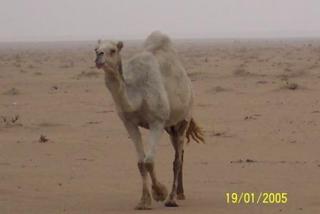 Fort Stewart's lush Georgia climate is a distant memory for those of us beaten down by Iraq's desert heat. We actually had a few 150+ days this summer, with most summer day highs averaging around 120 degrees. The experience is similar to the sensation you've had when opening the oven door to ckeck on the homemade bread--mmmmm homemade bread. Perhaps that which best approximates the experience is holding a hair dryer on high heat blowing directly into one's face. And yet, going from 120-30 degree arid Iraq to 90-100 degree Georgia for R&R a month ago, I was reminded--humidity can make all the difference.
Fort Stewart's lush Georgia climate is a distant memory for those of us beaten down by Iraq's desert heat. We actually had a few 150+ days this summer, with most summer day highs averaging around 120 degrees. The experience is similar to the sensation you've had when opening the oven door to ckeck on the homemade bread--mmmmm homemade bread. Perhaps that which best approximates the experience is holding a hair dryer on high heat blowing directly into one's face. And yet, going from 120-30 degree arid Iraq to 90-100 degree Georgia for R&R a month ago, I was reminded--humidity can make all the difference.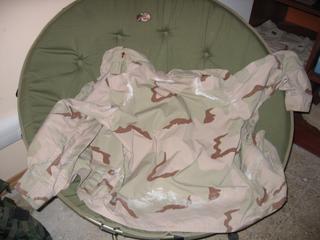 As I mentioned in a previous post, we wear body armor and kevlar headgear whenever we go outside. This makes the heat even more unbearable. Soldiers sweat a great deal, but the air is so dry it seems to evaporate instantly. However, when we are outside a lot, we sweat a great deal, and it evaporates everywhere air can get to. That leaves us mostly dry except where our body armor is pressed against our chest and back. Well, the material of our desert camo tops around the edges of the body armor develop salt formations on them because it stays dry, but keeps absorbing from the wet material under the armor--we call these salt stains "salt snakes". (Look carefully at the photo of my DCU top.)
As I mentioned in a previous post, we wear body armor and kevlar headgear whenever we go outside. This makes the heat even more unbearable. Soldiers sweat a great deal, but the air is so dry it seems to evaporate instantly. However, when we are outside a lot, we sweat a great deal, and it evaporates everywhere air can get to. That leaves us mostly dry except where our body armor is pressed against our chest and back. Well, the material of our desert camo tops around the edges of the body armor develop salt formations on them because it stays dry, but keeps absorbing from the wet material under the armor--we call these salt stains "salt snakes". (Look carefully at the photo of my DCU top.)This being said, as I walked to our house last night I noticed lightening in the far northeast sky--something we haven't seen since early April. Around midnight it rained, and the weather was gorgeous this morning. It has been cooling down lately, with highs in the 100s. This morning it was probably 70, and the air was noticeably cleaner from the rain.
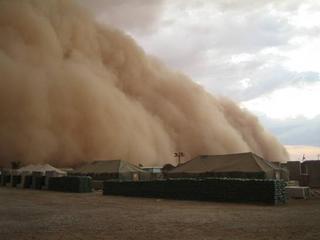 It can get very dusty, and dust storms are miserable and difficult to avoid, as dust finds its way through the smallest cracks of every building. Most sand stroms are not as sudden as the one pictured here. Usually, it's just a dusty haze that settles in, and then before long it's time for the goggles and perpetual dusk.
It can get very dusty, and dust storms are miserable and difficult to avoid, as dust finds its way through the smallest cracks of every building. Most sand stroms are not as sudden as the one pictured here. Usually, it's just a dusty haze that settles in, and then before long it's time for the goggles and perpetual dusk.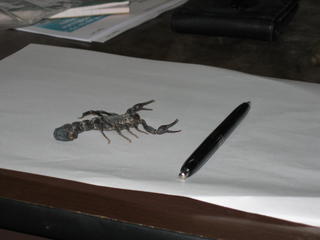 This morning as I lifted my armor to put it on, something fell to the ground with a "plop"--I noticed it was a scorpion and it was scurrying under my bed. In my effort to kick it out of my doorway, I killed it. (I placed a pen next to the dead critter for perspective--see picture.) We have a poster in our gym that identifies the various spiders and scorpions of the desert; this one is listed as most deadly. That would stink to successfully avoid bombs and gunfire, only to be sent home to recover from an insect sting.
This morning as I lifted my armor to put it on, something fell to the ground with a "plop"--I noticed it was a scorpion and it was scurrying under my bed. In my effort to kick it out of my doorway, I killed it. (I placed a pen next to the dead critter for perspective--see picture.) We have a poster in our gym that identifies the various spiders and scorpions of the desert; this one is listed as most deadly. That would stink to successfully avoid bombs and gunfire, only to be sent home to recover from an insect sting. 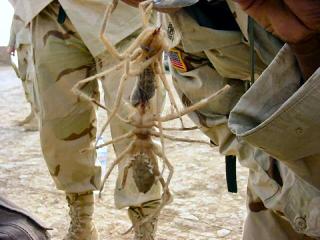 Camel spiders, although not poisonous, are another of the unsettling creatures of this desert; they are neither spiders nor scorpions but look like a hybrid of the two. (This picture is of one camel spider that has pinched onto another.) With the climate becoming cooler and wetter, we're sure to have some of these creepy critters looking for free rent! The picture at the top of this post is of a white camel: far more rare and valuable than the brown camels. We don't see many camels up here; they're mostly down south and in Kuwait: where we saw this one in January. The flies in Iraq are more agressive in this desert. If they weren't so annoying, we could get used to them. To a large extent, they vanished in the extreme heat of the summer--but they'll soon be back.
Camel spiders, although not poisonous, are another of the unsettling creatures of this desert; they are neither spiders nor scorpions but look like a hybrid of the two. (This picture is of one camel spider that has pinched onto another.) With the climate becoming cooler and wetter, we're sure to have some of these creepy critters looking for free rent! The picture at the top of this post is of a white camel: far more rare and valuable than the brown camels. We don't see many camels up here; they're mostly down south and in Kuwait: where we saw this one in January. The flies in Iraq are more agressive in this desert. If they weren't so annoying, we could get used to them. To a large extent, they vanished in the extreme heat of the summer--but they'll soon be back. 
No comments:
Post a Comment